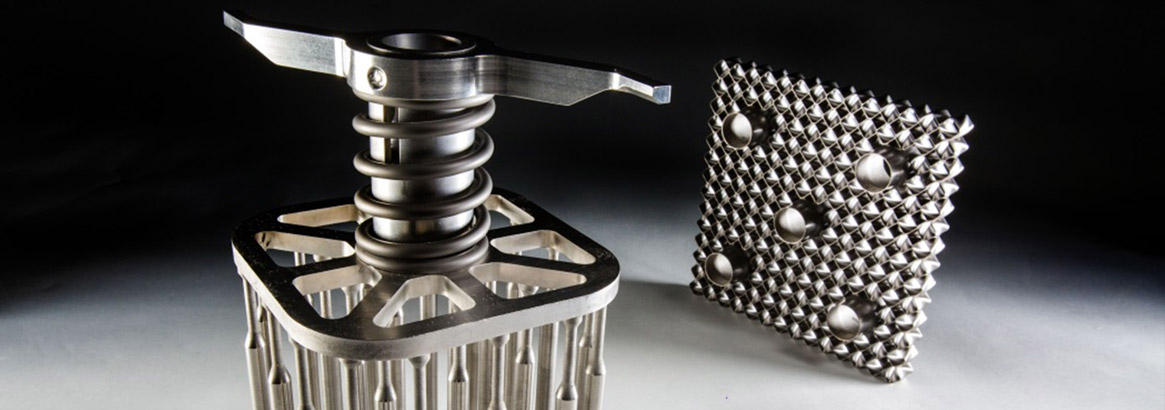Breaking the mold? Try eliminating the mold altogether.
Through innovative techniques like 3D printing, hot isostatic pressing and diffusion bonding, Westinghouse is developing and deploying advanced manufacturing technologies to realize cost and lead-time reductions, and enable next-generation solutions for energy generation. Explore some of our enhanced capabilities below.
Powder Bed Fusion Additive Manufacturing
Powder bed fusion is an additive manufacturing technique that uses either a laser or electron beam to melt and fuse material powder together, layer by layer. The laser or electron beam is aimed automatically at points in space (cross-sections) defined by a 3D model, fusing the material together to create a solid structure. After each cross-section is scanned the powder bed is lowered by one layer thickness, a new layer of powder material is applied on top, and the process is repeated until the part is completed.
Westinghouse is pursuing the use of powder bed fusion additive manufacturing for a number of applications, such as:
- Complex components required for performance gains: debris filtering bottom nozzles, advanced spacer grid, pumps components, heat exchangers and other next generation plant components
- Obsolete and difficult-to-procure components
- Unique components (prototypes, mockups, jigs / fixture, tooling, etc.)
Westinghouse is leading the efforts to implement additive manufacturing in nuclear. These efforts include:
- First-of-a-kind testing of irradiated additively manufactured 316L, Alloy 718 and Zr specimens
- Planned installation of the first additively manufactured component in a commercial reactor
Hot Wire Laser Welding
Hot wire laser welding (HWLW) utilizes a beam of coherent laser light that adds heat (via conduction) to achieve melting at the fusion point. The result is a superior level of welding precision and significantly higher production rates not achievable with conventional arc-based welding. This welding technology is being developed as a direct replacement for arc welding in fabrication, production and repair applications. HWLW offers the following proven benefits:
- Laser allows for “ultra-narrow groove” welding, creating a drastic decrease in joint volume and reducing welding time and welding costs
- Weld metal is deposited up to five times faster than conventional gas tungsten arc welding
- Combining fast weld speeds with smaller groove volume, HWLW can provide up to a 90 percent reduction in weld time
- Improved heat accuracy and welding precision resulting in improved weld quality with reduced reliance on unique welder skills
- Developed with Lincoln Electric Company, the welding system is based on “field hardened” Lincoln Equipment and patented Lincoln technology that is licensed exclusively to Westinghouse
Applications where HWLW is superior to conventional welding processes include heavy wall piping construction and management; major component repair and replacement; welds with stringent non-destructive examination (NDE) requirements; half-nozzle repairs and structural weld overlays; vessels and shells (reactor pressure vessel, steam generator, pressurizer, etc.); cladding and hardfacing; spent fuel canisters and cask liners; and potentially irradiated materials welding.
Cold Spray Coatings
In cold spray deposition, the powder particles of the coating material are propelled at supersonic velocities onto the surface of the substrate. This allows intimate contact between the exposed metal surfaces under high local pressure, permitting bonding to occur and thick layers of deposited material to be built up rapidly. In contrast to traditional thermal spray methods, cold spray produces coatings with low porosity and oxygen content, helping to limit potential thermal degradation and oxidation.
A number of materials have already been proven to be suitable for cold spraying including metals, refractory metals, alloys and composites. With these materials in mind, a wide range of applications can be explored. Westinghouse experts – along with our partners at the University of Wisconsin, Madison – have developed a cold spray process for coating zirconium-alloy reactor fuel cladding tubes. The chromium cold spray coating is now part of one of Westinghouse’s short-term products under its Accident Tolerant Fuel (ATF) program, EnCore® Fuel.
Please contact Marketing Manager Kris Paserba at 1-412-374-4971 for more information on Westinghouse’s advanced manufacturing capabilities.



